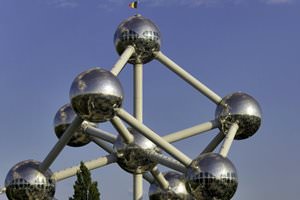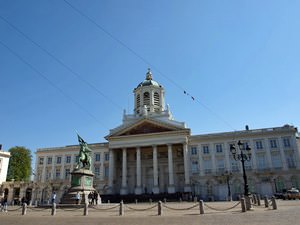Abbey of Our Lady of Peace, Liege
» A building was built a few years later. It has survived to this day.
» The project was provided by the first-ever architectress. Nun Antoinette Desmoulins developed the plan for the construction of a church. It was being built from 1686 to 1690.
» Its facade is very interesting. Columns combine several architectural styles. Some of them are stocky or massive, others are decorated with patterns. When the nun died suddenly, a bypass gallery was constructed along the perimeter of the building.
» The abbey was gradually extended. Later, a girls’ school was opened in the monastery. Here, girls studied theology, cookery, medicine, history, and exact sciences. The Benedictine Abbey of Our Lady of Peace was fame as a place where people learned to live without harming others but loving them as themselves.
» Nowadays, this school is a Jesuit boarding elementary and secondary educational institution.
Atomium, Brussels
Location on the map:  Interesting facts:
Interesting facts:
» Atomium is another great attraction of Brussels. This building was constructed for the opening of the World Expo 1958; that’s the symbol of the atomic age and the peaceful use of nuclear energy. » Construction of the Atomium is decorated with nine atoms united in a root fragment of the crystal lattice of iron magnified 165 billion times.
» CNN called this building the most bizarre one in Europe.
» The height of the entire structure is 102 meters, and the weight of the structure is about 2,400 tons. The diameter of each of the nine areas of construction is 18 meters.
» Six areas are available for visit. In the mid-pipe of the building, connecting the central sphere there is an elevator. It’s capable to lift the visitors to the restaurant and the viewing platform located in the highest ball of Atomium in 25 seconds.
Basilica of the Sacred Heart, Brussels
Location on the map:  Interesting facts:
Interesting facts:
» The Catholic Basilica of the Sacred Heart is dedicated to the Sacred Heart of Jesus. It was inspired by the eponymous basilica in Paris. » This shrine is the sixth area of the Roman Catholic Church in the world.
» The church is the large structure with two towers and a green copper dome towering 89 meters above the ground. The length of the building is almost 165 meters.
» In total the church can accommodate up to 2,000 people.
» The basilica houses a restaurant, a Catholic radio station, theater, two museums, and a place of training cavers and climbers.
Belfort, Brugge
Location on the map:  Interesting facts:
Interesting facts:
» Belfort is a guard tower built in 1240. The tower served as an observation point, from where it was possible to see an enemy from afar. » The tower is 83 m high.
» It is one of the symbols of modern Brugge.
» At the lower level of the building, there is the Archeology Museum that houses historical relics and pieces of art. In the tower, there is an art gallery and an observation platform.
» Belfort is also a tower with 47 bells, the biggest of which is named after Mary and was cast in the 17th century.
Brussels Town Hall, Brussels
Location on the map:  Interesting facts:
Interesting facts:
» The Brussels Town Hall is one of the most beautiful buildings in the city, which is the symbol of Brussels. » The 5-meter statue of the Archangel Michael, the patron saint of Brussels, throwing devil is installed at the 96-meter Gothic Tower.
» The oldest part of the town hall was built in 1420, and the other part of the building was completed a little later (in 1450).
» Facade of the Hall is decorated with numerous statues of nobles, saints, and allegorical figures. In fact, existing sculpture are only reproductions, and originals are kept in the House of the King.
» The Town Hall is still used as the residence of the mayor and is available for tours.
Cathedral of Christ the Savior, Brugge
» The cathedral is famous for its luxury interior, many religious relics and pieces of art.
» The walls of the cathedral are decorated with Brussels canvasses of the 18th century and multicolored paintings of the 19th century. Due to them, the cathedral looks festive.
» In the cathedral, there is a museum where you can see such precious artifacts, as “The Death of Hippolytus”, a triptych created by Dirk Bouts and Hugo van der Goes in 1470, and the painting “Golgotha”, one of the oldest canvasses in Brugge.
» The organ in the cathedral is the oldest in the country. It was created in the baroque style in 1717.
Cathedral of St. Michael and St. Gudula, Brussels
Location on the map:  Interesting facts:
Interesting facts:
» The Cathedral of St. Michael and St. Gudula is one of the main attractions of Brussels, and the clearest example of Gothic architecture. » The building of the cathedral is a symmetrical composition with two towers, within which there is a long staircase opening onto the terrace that is 64 meters high. The terrace offers a magnificent view of the city.
» The Cathedral has four doors decorated with wrought-reliefs and statues of saints. There is a huge stained glass above the main entrance.
» Stained glasses decorating the cathedral were created in the 16th century by Jan Haq and in 18-19th century by Jean-Baptiste Kaproner.
» The cathedral houses the mausoleum of the Belgian national hero Frederic de Merode.
Chapel Church, Brussels
Location on the map:  Interesting facts:
Interesting facts:
» The Chapel Church is one of the oldest churches in Brussels, the first mention of which dates back to 1134 year. During its long history the church has undergone many changes; it has repeatedly been destroyed and rebuilt. » There are graves of local nobility and famous people inside the church.
» Nowadays, the Chapel Church is the parish church of the Polish Catholic community in Brussels.
» You can see the entire collection of paintings, sculptures and stained glass inside the temple.
» The church regularly hosts a variety of concerts. It’s open to visitors all year round.
Church of Our Blessed Lady, Brussels
» The Church was built in the period from 1400 to 1594. It’s located near Small Sablon Park that was laid in honor of the great men of the sixteenth century.
» The church building is decorated with beautiful stained glass windows; bright interior lighting is turned on in the night.
» Since its construction in 1784, the church has being serving as the burial place for noble aristocratic families.
» The church is famous for its numerous sculptures adorning the facade of the building, its grounds and interior.
Church of Our Lady, Brugge
Location on the map:  Interesting facts:
Interesting facts:
» The Church of Our Lady is a construction that features the combination of Gothic and Roman styles. » The construction lasted over 2 years and was completed in the 13th century.
» In the spacious church with a 122-meter tower, the only sculpture of Michelangelo, “The Virgin Mary with the Baby”, is kept.
» Some windows of the church have the shape of a Reuleaux triangle. Such windows are quite rare.
» The church is famous for the fact that the wife of Maximilian I Mary of Burgundy who lived a short life was buried here. The emperor loved his wife very much and called her the most beautiful woman in the world.
Church of Saint-Jean, Liege
Location on the map:  Interesting facts:
Interesting facts:
» The octagonal church of St. Jean looks bleak and strict. » The church is named Saint-Jean-en-Lille, which means “a temple on the island”). The first building was built on the plot surrounded by water.
» The founder of the church was Bishop Notger. The bishop expressed his gratitude to God for assistance in captivating the Chevremon Fortress. The warrior found rest here. The tomb with his relics was lost due to the overflow of the river. The sarcophagus of the leader was restored but his remnants were not found. The flood gave an impetus to the building reconstruction.
» Italian and Liege architects worked on the project. Only a bell tower built in the Roman style has survived.
» At the Saint-Jean-en-Lille, pieces of sacred art are kept: the wooden sculpture of Apostle John and the Mother of God with a baby (1230), paintings from the Late Middle Ages, a carved cross, and wooden lockets depicting St. Paul and Peter. On the altar, there is the preserved gospel dating back to 1564.
» The interior is distinguished by stained glass windows of the 16th century, furniture on the baroque style, and a carved Gothic vault.
Church of St. Bartholomew, Liege
Location on the map:  Interesting facts:
Interesting facts:
» The Church of St. Bartholomew attracts with its exterior. Vertical ledges of red columns contrast with the background of the white sandstone walls. » A lot of pilgrims following the road of St. Jacob visited the church.
» The unfinished building was blessed when the foundation was laid.
» The Church of St. Bartholomew built in the Roman style is located beyond the city.
» There are two similar bell towers at the sides of the church.
» In the hall, you can see paintings by eminent artists. The main theme of canvasses is the glorification of Jesus.
» You can also see a brass bowl here. A font was built in the 12th century. The bowl is installed on the backs of bulls. There were 12 statues of animals but two of them have been lost. These bulls represent twelve followers of Christ. The walls of the font are decorated with five relief paintings depicting scenes from the life of celestial beings. The fineness of details really impresses. The font is placed on a pedestal in a separate room.
» The restoration of the building lasted 7 years and was completed in 2006. The colorful ornament on painted walls was renovated. It had to change 10 000 tiles.
Church of St. Catherine, Brussels
» The interior is very bright due to the white plaster on the walls; it’s designed in neo-Renaissance style.
» The belfry standing apart from the temple is actually much older than the Church of St. Catherine. It has been preserved from the old church, which stood on that site previously.
» The main altar of the church is decorated with painting The Assumption of St. Catherine.
Church of St. Jacques, Liege
» The building has the shape of a cross. Windows are big and transmit much daylight. Stained glass with pictures of 32 heraldic craftsmen’ emblems was made in the 16th century. Wall panels are decorated with frescoes created at the same time. The long hallway is decorated with carved stone laces and a lot of statues. On the vault, you can see 150 pyramidal decorative elements distinguished by a unique ornament.
» A modern organ (1998) was placed in the body of the old instrument (1600).
» The Gothic Church was consecrated in honor of James, son of Alphaeus. Little is known about the apostle and the follower of Christ. It is known from Lives of Saints that James preached in Judea. According to one version, he was stoned by Jews to death. According to the other legend, he was crucified for his belief when he traveled to Egypt.
» The House of God is located in the historic center of the city.
» Before, the church had belonged to the Benedictine Abbey. In 1801, the abbey was demolished but the prayer house is still used.












